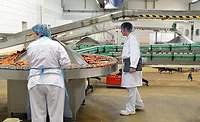Building the perfect plant

The place to start when building the perfect plant is the floor. If the floor is installed poorly, designed improperly or constructed of the wrong materials, you are asking for trouble. Once the plant floor begins to fail, the costs for repair or replacement can be enormous. In addition, it is almost impossible to keep production running while making repairs. A damaged floor is almost impossible to clean and may be contaminated. Such a floor may harbor pests since cracks, pits and crevices trap food, especially in dry operations.
There are a number of aspects that must be decided such as the type of product to be processed, drain size and type, the amount of water that will be used during production and cleaning, whether waste will be swept or washed into drains, the floor's grade, plant layout and future expansions. Processors also need to balance sanitation and safety. Floors should be constructed of materials that minimize slips and are easy to clean.
Concrete with a seal or coating is probably the most common floor found in food plants. Other options include tile or brick. With the latter, there is a concern about breakage and/or water getting under the tile. Once one tile starts to go, they all begin to fail.
Selecting the wrong type of flooring, coating or epoxy can also create serious problems. For example, if you are producing an acidic product such as pickles, juices or tomato-based products, the floor must be acid resistant. Acids used in processing vinegar and juices will attack a concrete floor that is not protected.
Years ago I received an invitation to attend the grand opening of a pickle plant. The owners were proud of their sanitary design. They did everything perfectly except they did not put a seal on the concrete floor. It was embarrassing to attend an opening and have to suggest that they stop production and clean and dry the floor completely in preparation for properly finishing it. Pickle brine with a salt and a pH of 3.5 would have destroyed the floor in short order.
This article is the first in a series that will focus on basic plant techniques to ensure food safety.
Looking for a reprint of this article?
From high-res PDFs to custom plaques, order your copy today!



